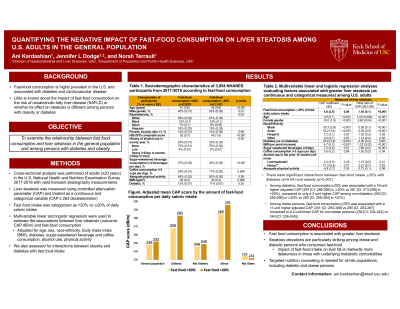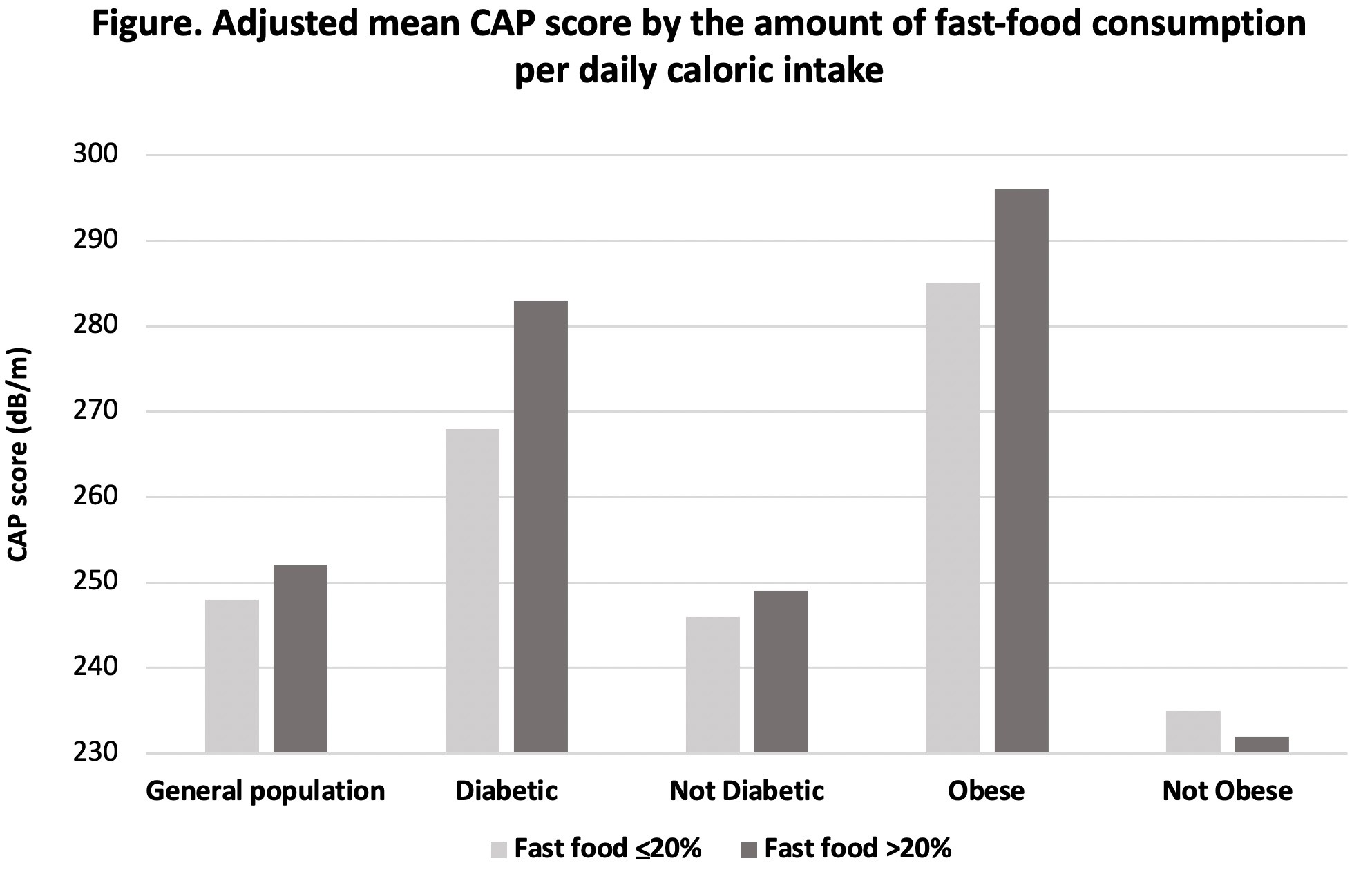Back


Poster Session B - Monday Morning
Category: Liver
B0516 - Quantifying the Negative Impact of Fast-Food Consumption on Liver Steatosis Among U.S. Adults in the General Population
Monday, October 24, 2022
10:00 AM – 12:00 PM ET
Location: Crown Ballroom

Has Audio

Ani Kardashian, MD
University of Southern California
Los Angeles, CA
Presenting Author(s)
Ani Kardashian, MD, Jennifer L. Dodge, MPH, Norah A. Terrault, MD, MPH
University of Southern California, Los Angeles, CA
Introduction: Fast food (FF) consumption is highly prevalent in the US and is associated with high caloric intake and greater risk of diabetes. Little is known about the impact of FF consumption on NAFLD risk in healthy adults or whether the effect of FF on steatosis is different among persons with metabolic risk factors, including obesity and diabetes. We aimed to evaluate the quantitative impacts of FF consumption on steatosis risk in these populations.
Methods: Adults (≥20 years) in the U.S. National Health and Nutrition Examination Survey 2017-2018 with valid transient elastography and FF data were included. Liver steatosis was measured continuously using the controlled attenuated parameter score (CAP; dB/m). FF intake was assessed using the two-day food frequency questionnaire and calculated as the percentage of daily calories from FF (either as an average of the two-day total or one day if only one day was available). We used multivariable linear regression to examine the association of FF consumption with steatosis.
Results: 3,954 adults were included, of whom 2037 (52%) consumed any FF and 1,147 (29%) consumed >20% of daily calories from FF. Subjects consuming >20% of daily calories from FF (vs ≤20%) were more likely to be younger (42 vs 50 years), male (53% vs 47%), obese (50% vs 40%), consume sugar-sweetened beverages (SSBs; 43% vs 27%) and less likely to drink coffee (17% versus 24%). In the multivariable models, FF intake >20% of daily caloric intake was associated with a 4.3-point higher CAP (standard error [SE] 1.9) after controlling for age, gender, race/ethnicity, diabetes, body mass index, and consumption of SSBs or coffee. We identified interactions between FF intake >20% and metabolic comorbidities, including obesity (p< 0.001) and diabetes (p=0.054). Among diabetics, FF intake >20% (vs ≤20%) was associated with a 15.7-unit higher CAP (283[4.3] vs 268[4.2]), compared to only a 2.9-unit higher CAP among non-diabetics (249[1.4] vs 246[1.7]; Figure). Among obese persons, FF intake >20% was associated with a 11-unit higher CAP (296[3.1] vs 285[3.4]) compared to a 3-unit lower CAP compared to non-obese persons (232[1.4] vs 235[1.7]).
Discussion: Fast food consumption is associated with greater liver steatosis in the U.S. population, with striking elevations in risk among obese and diabetic persons. These findings should urge education around magnitude of risk among persons with obesity and diabetes and encourage policy efforts to improve access to healthier food options in the US.

Disclosures:
Ani Kardashian, MD, Jennifer L. Dodge, MPH, Norah A. Terrault, MD, MPH. B0516 - Quantifying the Negative Impact of Fast-Food Consumption on Liver Steatosis Among U.S. Adults in the General Population, ACG 2022 Annual Scientific Meeting Abstracts. Charlotte, NC: American College of Gastroenterology.
University of Southern California, Los Angeles, CA
Introduction: Fast food (FF) consumption is highly prevalent in the US and is associated with high caloric intake and greater risk of diabetes. Little is known about the impact of FF consumption on NAFLD risk in healthy adults or whether the effect of FF on steatosis is different among persons with metabolic risk factors, including obesity and diabetes. We aimed to evaluate the quantitative impacts of FF consumption on steatosis risk in these populations.
Methods: Adults (≥20 years) in the U.S. National Health and Nutrition Examination Survey 2017-2018 with valid transient elastography and FF data were included. Liver steatosis was measured continuously using the controlled attenuated parameter score (CAP; dB/m). FF intake was assessed using the two-day food frequency questionnaire and calculated as the percentage of daily calories from FF (either as an average of the two-day total or one day if only one day was available). We used multivariable linear regression to examine the association of FF consumption with steatosis.
Results: 3,954 adults were included, of whom 2037 (52%) consumed any FF and 1,147 (29%) consumed >20% of daily calories from FF. Subjects consuming >20% of daily calories from FF (vs ≤20%) were more likely to be younger (42 vs 50 years), male (53% vs 47%), obese (50% vs 40%), consume sugar-sweetened beverages (SSBs; 43% vs 27%) and less likely to drink coffee (17% versus 24%). In the multivariable models, FF intake >20% of daily caloric intake was associated with a 4.3-point higher CAP (standard error [SE] 1.9) after controlling for age, gender, race/ethnicity, diabetes, body mass index, and consumption of SSBs or coffee. We identified interactions between FF intake >20% and metabolic comorbidities, including obesity (p< 0.001) and diabetes (p=0.054). Among diabetics, FF intake >20% (vs ≤20%) was associated with a 15.7-unit higher CAP (283[4.3] vs 268[4.2]), compared to only a 2.9-unit higher CAP among non-diabetics (249[1.4] vs 246[1.7]; Figure). Among obese persons, FF intake >20% was associated with a 11-unit higher CAP (296[3.1] vs 285[3.4]) compared to a 3-unit lower CAP compared to non-obese persons (232[1.4] vs 235[1.7]).
Discussion: Fast food consumption is associated with greater liver steatosis in the U.S. population, with striking elevations in risk among obese and diabetic persons. These findings should urge education around magnitude of risk among persons with obesity and diabetes and encourage policy efforts to improve access to healthier food options in the US.

Figure: Adjusted mean CAP score by the amount of fast-food consumption per daily caloric intake
Disclosures:
Ani Kardashian indicated no relevant financial relationships.
Jennifer Dodge indicated no relevant financial relationships.
Norah Terrault: DURECT Corp – Grant/Research Support. Gilead Sciences – Grant/Research Support. Glaxo-Smith-Kline – Grant/Research Support. Helio Health – Grant/Research Support. Moderna (DSMB) – Advisory Committee/Board Member. Roche-Genentech – Grant/Research Support.
Ani Kardashian, MD, Jennifer L. Dodge, MPH, Norah A. Terrault, MD, MPH. B0516 - Quantifying the Negative Impact of Fast-Food Consumption on Liver Steatosis Among U.S. Adults in the General Population, ACG 2022 Annual Scientific Meeting Abstracts. Charlotte, NC: American College of Gastroenterology.

